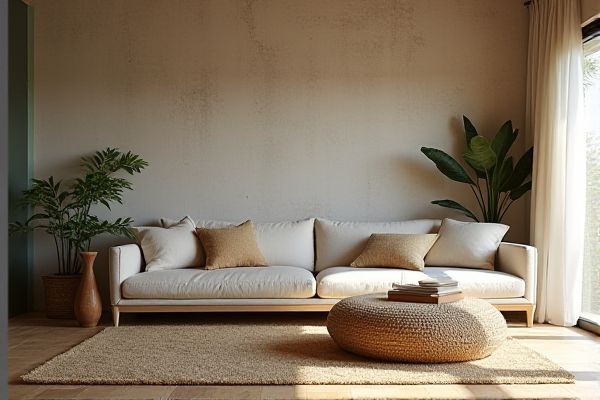
Synthetic rope offers superior durability and resistance to moisture and UV damage, making it ideal for long-lasting outdoor furniture. Discover which rope type best suits your furniture needs by reading the rest of the article.
Table of Comparison
| Feature | Synthetic Rope Furniture | Natural Rope Furniture |
|---|---|---|
| Material | Polypropylene, nylon, polyester | Manila, sisal, jute, hemp |
| Durability | High resistance to UV, water, abrasion | Prone to wear, rotting, and mold in moisture |
| Maintenance | Low maintenance, easy to clean | Requires regular treatment and drying |
| Weather Resistance | Excellent for outdoor use | Less suitable for prolonged outdoor exposure |
| Strength | Consistent tensile strength | Variable strength depending on fiber quality |
| Appearance | Modern, uniform look, available in colors | Rustic, natural texture and color |
| Environmental Impact | Non-biodegradable, synthetic waste | Biodegradable, eco-friendly |
| Cost | Generally more expensive | More affordable but varies by fiber type |
Introduction to Rope Furniture Materials
Synthetic rope furniture offers enhanced durability, UV resistance, and water repellency, making it ideal for outdoor settings exposed to various weather conditions. Natural rope furniture, crafted from materials like jute, sisal, or cotton, provides an organic aesthetic and softer texture but requires more maintenance to prevent wear and degradation. Your choice between synthetic and natural rope furniture depends on factors like intended use, exposure to elements, and desired look and feel.
Overview of Synthetic Rope in Furniture
Synthetic rope in furniture offers unparalleled durability, resistance to moisture, UV rays, and mildew, making it ideal for both indoor and outdoor use. Unlike natural rope, synthetic fibers like polyester or nylon maintain strength and color over time, ensuring your furniture stays resilient and visually appealing. Selecting synthetic rope enhances your furniture's lifespan and reduces maintenance needs, especially in demanding environments.
Overview of Natural Rope in Furniture
Natural rope in furniture is crafted from fibers like jute, sisal, or hemp, offering an organic texture and rustic aesthetic that enhances eco-friendly interiors. Its breathable properties and natural resistance to UV rays make it suitable for indoor and covered outdoor furniture, though it requires regular maintenance to prevent wear and fraying. Choosing natural rope furniture adds warmth and sustainability to your space, complementing designs that prioritize environmental consciousness.
Aesthetic Differences: Synthetic vs Natural Rope
Synthetic rope furniture offers a sleek, uniform appearance with vibrant color options and consistent texture, enhancing modern and contemporary decor styles. Natural rope furniture showcases organic textures, warm tones, and subtle variations that add rustic charm and a handcrafted feel to outdoor and coastal-inspired spaces. The choice between synthetic and natural rope significantly impacts the visual appeal, influencing both the furniture's style and the ambiance of the surrounding environment.
Durability and Longevity Comparison
Synthetic rope furniture offers superior durability and longevity compared to natural rope furniture, as it resists UV rays, moisture, and mildew more effectively. Natural rope, such as jute or cotton, tends to degrade faster due to exposure to outdoor elements, leading to fraying and weakening over time. Choosing synthetic rope ensures your furniture maintains structural integrity and aesthetic appeal for several years, making it a more reliable investment for outdoor use.
Maintenance and Cleaning Requirements
Synthetic rope furniture requires minimal maintenance, as it resists moisture, mold, and UV damage, allowing for easy cleaning with soap and water. Natural rope furniture demands more frequent upkeep to prevent mildew and deterioration, often requiring specialized cleaning products and treatments to maintain its appearance. The durability and weather resistance of synthetic fibers significantly reduce cleaning frequency compared to the porous and absorbent nature of natural rope.
Environmental Impact and Sustainability
Synthetic rope furniture is often made from petroleum-based materials like nylon or polypropylene, which contribute to plastic pollution and have a higher carbon footprint compared to natural fibers. Natural rope furniture, crafted from materials such as jute, hemp, or cotton, offers biodegradability and renewability, making it a more sustainable choice for eco-conscious consumers. You can reduce environmental impact by choosing natural rope furniture that supports sustainable farming and processing practices.
Comfort and Outdoor Performance
Synthetic rope furniture offers superior comfort and outdoor performance due to its resistance to moisture, UV rays, and mildew, ensuring durability and minimal maintenance. Natural rope furniture provides a softer, more organic feel but tends to absorb water, leading to quicker degradation and less suitability for prolonged outdoor exposure. The choice depends on balancing aesthetic warmth with the need for weather-resistant, long-lasting outdoor comfort.
Cost Analysis: Synthetic vs Natural Rope Furniture
Synthetic rope furniture generally offers a more cost-effective solution compared to natural rope due to lower material and maintenance expenses. While natural rope furniture provides an authentic aesthetic, it often requires frequent upkeep and replacement, increasing long-term costs. Choosing synthetic rope can help you save money while enjoying durable, weather-resistant furniture for your space.
Choosing the Right Rope Furniture for Your Space
Synthetic rope furniture offers enhanced durability, weather resistance, and low maintenance, making it ideal for outdoor spaces exposed to moisture and sun. Natural rope furniture provides a warm, authentic aesthetic with biodegradable materials that suit indoor or covered environments where longevity is less demanding. Consider your space's exposure to elements and desired style to select the right rope furniture that balances functionality and design for your home or patio.
 homyna.com
homyna.com